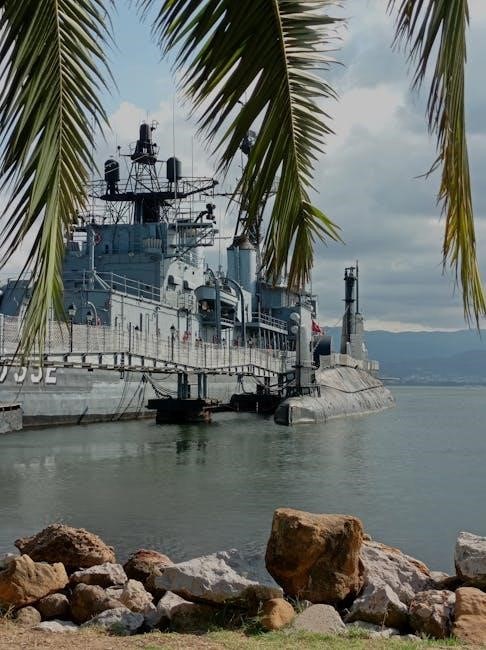The Russian Navy operates a formidable submarine fleet‚ inheriting a legacy from the Soviet Union. Modernization efforts focus on advanced classes like Borei and Yasen‚ ensuring strategic nuclear deterrence and multirole capabilities in global operations.
1.1 Historical Overview of the Russian Navy’s Submarine Fleet
The Russian Navy’s submarine fleet traces its origins to the Soviet era‚ inheriting a vast and technologically advanced force. During the Cold War‚ Soviet submarines played a critical role in strategic deterrence and naval operations. Post-Soviet era‚ the fleet faced challenges‚ including budget cuts and aging vessels. However‚ modernization efforts have revitalized the fleet‚ with classes like Typhoon and Borei showcasing Russia’s commitment to maintaining a formidable underwater presence. Historical milestones include the development of nuclear-powered submarines and the integration of advanced missile systems‚ ensuring the fleet remains a cornerstone of Russian naval power and strategic capabilities.
1.2 The Importance of Submarines in Modern Naval Warfare
Submarines are a cornerstone of modern naval warfare‚ offering strategic deterrence‚ stealth capabilities‚ and multirole operational flexibility. For the Russian Navy‚ submarines play a pivotal role in ensuring national security through nuclear deterrence and conventional warfare. They can execute missions ranging from intelligence gathering to launching ballistic missiles‚ making them indispensable in both offensive and defensive strategies. Their ability to operate undetected enhances their effectiveness in controlling sea lanes and projecting power globally. As global tensions rise‚ submarines remain a critical component of naval power‚ ensuring Russia’s ability to respond to emerging threats and maintain its geopolitical influence effectively.

Classes of Russian Navy Submarines
Russia’s submarine fleet includes Borei-class ballistic missile submarines‚ Yasen-class multipurpose submarines‚ Akula-class attack submarines‚ Oscar II-class cruise missile submarines‚ Kilo-class diesel-electric submarines‚ and Lada-class air-independent propulsion submarines‚ ensuring strategic and operational versatility.
2.1 Borei-class Ballistic Missile Submarines (SSBN)

The Borei-class submarines are Russia’s latest generation of ballistic missile submarines‚ designed to serve as the backbone of the naval component of the country’s nuclear deterrent. These submarines are equipped with advanced Bulava intercontinental ballistic missiles‚ capable of delivering nuclear warheads across vast distances. The Borei-class features improved stealth capabilities‚ enhanced acoustic signature reduction‚ and advanced communication systems‚ ensuring operational effectiveness in strategic missions. With a length of over 170 meters and a displacement of approximately 24‚000 tons‚ these submarines represent a significant leap in Russian submarine technology‚ ensuring the nation’s ability to maintain a robust nuclear deterrent in the modern era.
2.2 Yasen-class Multipurpose Nuclear Submarines (SSGN)
The Yasen-class represents Russia’s most advanced multipurpose nuclear submarines‚ designed for a wide range of missions‚ including anti-submarine and anti-surface warfare. Equipped with Kalibr cruise missiles‚ Oniks anti-ship missiles‚ and torpedoes‚ these submarines are highly versatile. Their stealth technology and advanced propulsion systems enable them to operate effectively in both open ocean and littoral environments. With a length of 119 meters and a displacement of 13‚800 tons‚ the Yasen-class combines speed‚ maneuverability‚ and firepower‚ making them a critical asset for the Russian Navy’s strategic and tactical operations. Their multirole capability ensures they remain a cornerstone of Russia’s naval power projection capabilities.
2.3 Akula-class Attack Submarines (SSN)
The Akula-class is a cornerstone of Russia’s submarine fleet‚ excelling in anti-submarine and anti-surface warfare. These SSNs are known for their advanced stealth capabilities‚ achieving low acoustic signatures through innovative design. Equipped with torpedoes‚ anti-ship missiles‚ and mines‚ they are highly versatile. The Akula-class also features a strong focus on endurance‚ enabling long-range operations. Their nuclear reactors provide sustained power‚ enhancing their operational readiness. As a key component of Russia’s naval defense‚ the Akula-class remains a formidable force‚ ensuring the nation’s underwater security and strategic interests in various maritime regions.
2.4 Oscar II-class Cruise Missile Submarines (SSG)
The Oscar II-class submarines are among the largest attack submarines in the world‚ designed for multirole operations. They are equipped with P-700 Granit anti-ship missiles‚ offering long-range strike capabilities. These SSGs feature advanced stealth technology and robust sensors‚ making them highly effective in deep-water missions. Their nuclear reactors ensure prolonged endurance‚ allowing them to operate across vast oceanic regions. The Oscar II-class plays a critical role in Russia’s naval strategy‚ providing a significant deterrent and offensive capability in both conventional and strategic scenarios. Their presence underscores Russia’s commitment to maintaining a powerful underwater fleet.
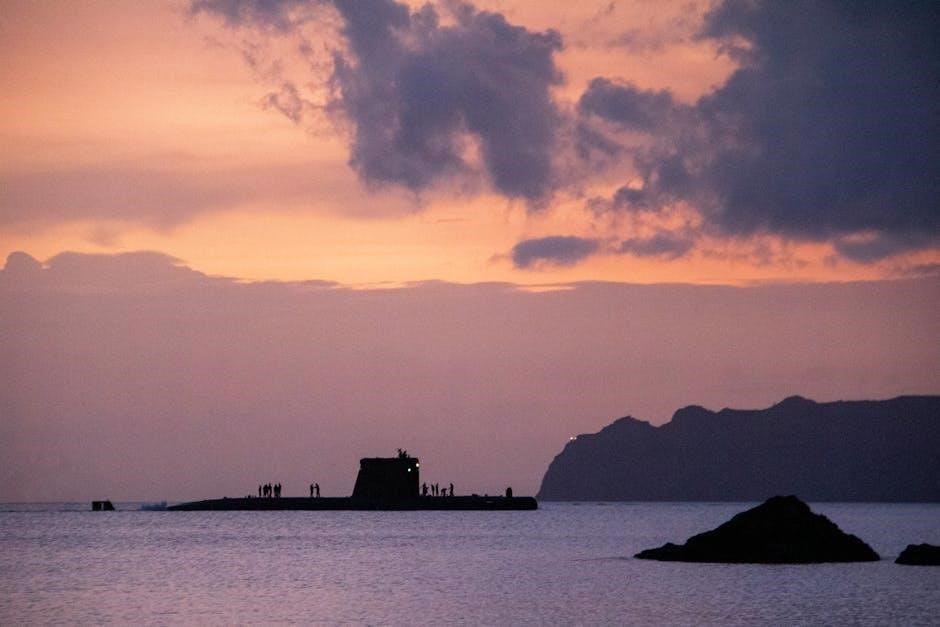
2.5 Kilo-class Diesel-Electric Submarines (SSK)
The Kilo-class submarines are highly advanced diesel-electric vessels known for their exceptional stealth and endurance. Designed for coastal defense and surveillance‚ they are equipped with torpedoes and mines‚ making them versatile for anti-submarine and anti-surface warfare. Their compact design allows operation in shallow waters‚ enhancing their effectiveness in littoral zones. With a strong export history‚ the Kilo-class has been delivered to multiple nations‚ showcasing their reliability and durability. Their operational capabilities include supporting surface fleets and conducting intelligence-gathering missions‚ making them a cornerstone of Russia’s conventional submarine force. Their quiet propulsion system and robust armament ensure they remain a formidable asset in naval operations.

2.6 Lada-class Air-Independent Propulsion Submarines
The Lada-class submarines represent a significant leap in Russian submarine technology‚ utilizing air-independent propulsion (AIP) for enhanced underwater endurance. These vessels are designed for multirole operations‚ including anti-submarine warfare‚ surveillance‚ and reconnaissance. Their AIP system allows prolonged submerged operations without snorkeling‚ reducing acoustic signature and boosting stealth. Equipped with advanced torpedoes and mines‚ the Lada-class excels in coastal and blue-water missions. Despite initial development challenges‚ these submarines demonstrate Russia’s commitment to modernizing its fleet with quieter‚ more efficient platforms. Their compact size and versatility make them ideal for various naval strategies‚ ensuring the Russian Navy remains competitive in underwater warfare capabilities.
2.7 Delta IV-class Ballistic Missile Submarines (SSBN)
The Delta IV-class submarines are a critical component of Russia’s strategic nuclear deterrent. Commissioned in the late 1980s‚ these SSBNs remain operational‚ carrying 16 RSM-54 Skiff ballistic missiles each. Designed for longevity‚ they have undergone modernization to extend their service life. Despite the introduction of newer Borei-class submarines‚ the Delta IVs continue to play a vital role in Russia’s nuclear triad. Their reliability and endurance ensure the Russian Navy’s ability to maintain a strategic nuclear presence. Modernization efforts include upgrades to their missile systems‚ ensuring their relevance in contemporary naval operations. The Delta IV-class underscores Russia’s commitment to sustaining its nuclear capabilities at sea.
2.8 Typhoon-class Ballistic Missile Submarines (SSBN)
The Typhoon-class‚ designated as SSBNs‚ are among the largest submarines ever built. Initially developed in the 1980s‚ these vessels are designed to withstand extreme conditions‚ including Arctic operations. Each Typhoon-class submarine carries 20 RSM-52 Bulava ballistic missiles‚ serving as a cornerstone of Russia’s nuclear deterrent. Their massive size and double-hull design enhance survivability and operational capabilities. Although only a limited number remain in active service‚ they are being gradually replaced by the Borei-class submarines. The Typhoon-class exemplifies Soviet engineering prowess and continues to contribute to Russia’s strategic nuclear capabilities‚ ensuring a robust underwater presence in the Arctic region.
2;9 Antey-class Ballistic Missile Submarines (SSBN)
The Antey-class‚ also known as the Delta IV-class‚ is a series of ballistic missile submarines operated by the Russian Navy. Designed in the 1980s‚ these submarines play a critical role in Russia’s nuclear deterrence strategy. Each Antey-class SSBN carries 16 R-29RMU Sineva ballistic missiles‚ capable of delivering multiple warheads over intercontinental distances. Known for their reliability and endurance‚ these submarines are primarily deployed in the Northern Fleet. While they are being gradually replaced by the Borei-class‚ the Antey-class remains operational‚ ensuring Russia’s strategic nuclear capabilities at sea. Their service has been extended through modernization efforts‚ maintaining their relevance in modern naval operations.
Technical Specifications and Advancements
Russian navy submarines feature advanced propulsion systems‚ enhanced stealth capabilities‚ and sophisticated weapon systems‚ ensuring superior performance in underwater operations and strategic missions.
3.1 Propulsion Systems: Nuclear vs. Diesel-Electric
Russian submarines utilize two primary propulsion systems: nuclear and diesel-electric. Nuclear-powered submarines‚ such as the Borei and Yasen classes‚ offer superior endurance and operational range‚ enabling prolonged missions without refueling. Diesel-electric submarines‚ like the Kilo-class‚ excel in stealth due to their quieter operation but require surface access for battery charging. The choice between these systems reflects strategic priorities‚ with nuclear submarines focusing on long-range deterrence and diesel-electric vessels excelling in coastal defense and anti-submarine warfare. Both technologies underscore Russia’s commitment to maintaining a versatile and capable underwater fleet.
3.2 Stealth Technology and Acoustic Signature Reduction
Russian submarines emphasize stealth technology to evade detection‚ employing advanced acoustic signature reduction methods. These include anechoic coatings‚ streamlined hull designs‚ and raised propeller systems. The Yasen-class submarines‚ for instance‚ feature multi-layered insulation to minimize noise. Additionally‚ Russian submarines utilize air-independent propulsion systems‚ which reduce the need for frequent surfacing‚ enhancing stealth. These advancements allow Russian submarines to operate undetected in strategic waters‚ providing a critical advantage in both offensive and defensive operations. Continuous research and development ensure Russian submarines remain among the quietest in the world‚ maintaining their effectiveness in modern naval warfare.
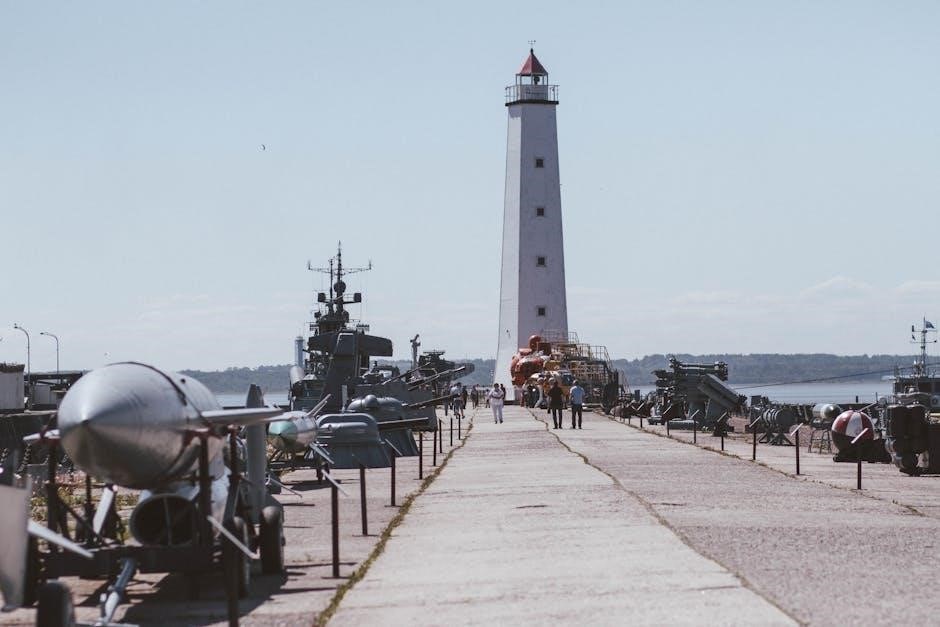
3.3 Weapons and Armament: Missiles‚ Torpedoes‚ and Mines
Russian submarines are equipped with an array of advanced weapons‚ including ballistic and cruise missiles‚ torpedoes‚ and mines. The Borei-class submarines carry RSM-56 Bulava ballistic missiles‚ capable of delivering nuclear warheads. Yasen-class submarines are armed with Kalibr cruise missiles‚ enabling long-range precision strikes. Additionally‚ Russian submarines deploy advanced torpedoes‚ such as the Type 65-76A‚ which feature increased speed and range. Mines are also used for area denial‚ enhancing the submarine’s strategic and tactical versatility. This diverse armament allows Russian submarines to conduct multiple mission profiles‚ from nuclear deterrence to conventional warfare‚ ensuring their effectiveness across various operational scenarios.
3.4 Electronic Warfare and Communication Systems
Russian submarines are equipped with sophisticated electronic warfare (EW) and communication systems‚ enabling them to operate effectively in contested environments. These systems include advanced sensors‚ jamming capabilities‚ and encrypted communication channels. Submarines can detect and disrupt enemy electronic signals‚ ensuring operational stealth. Communication systems utilize satellite links and low-probability-of-intercept protocols to maintain contact with command structures while minimizing detection risks.
Such technologies are critical for strategic nuclear deterrence and conventional operations‚ allowing Russian submarines to coordinate missions and respond to threats in real-time. These systems underscore the navy’s commitment to maintaining technological superiority in underwater warfare.
Strategic Role and Operational Capabilities
Russian submarines play a pivotal role in strategic deterrence and multirole operations‚ ensuring nuclear capabilities and conventional warfare readiness. Their presence across global regions enhances naval dominance and operational flexibility.
4.1 Strategic Deterrence and Nuclear Capabilities
The Russian Navy’s submarines play a critical role in strategic deterrence‚ ensuring the country’s ability to project nuclear power globally. Equipped with ballistic missiles‚ such as the RSM-56 Bulava‚ these vessels guarantee a second-strike capability‚ deterring potential adversaries. The Borei-class and Typhoon-class submarines are central to this mission‚ operating stealthily to avoid detection. Their nuclear arsenals are designed to survive and respond to any nuclear attack‚ maintaining Russia’s strategic security. This capability ensures geopolitical stability and underscores the navy’s commitment to national defense‚ reinforcing its status as a key player in global strategic affairs and nuclear deterrence frameworks.
4.2 Conventional Warfare and Multirole Operations
Russian submarines excel in conventional warfare‚ offering multirole capabilities that enhance naval operations. Beyond their nuclear deterrent role‚ these submarines can engage in anti-surface and anti-submarine warfare‚ using advanced torpedoes and cruise missiles. The Yasen-class‚ for instance‚ is designed for multirole missions‚ enabling it to strike land targets and enemy ships effectively. Additionally‚ Russian submarines can conduct intelligence-gathering and special operations‚ providing operational flexibility. Their presence in global waters ensures a robust conventional defense capability‚ supporting maritime security and projecting power beyond Russia’s borders. This versatility underscores the Russian Navy’s commitment to maintaining a balanced and capable submarine fleet for diverse operational needs.
4.3 Regional Presence: Pacific‚ Arctic‚ and Atlantic Fleets
Russia’s submarine fleet is strategically distributed across its Pacific‚ Arctic‚ and Atlantic bases‚ ensuring a robust regional presence. The Pacific Fleet operates from bases in Kamchatka‚ supporting operations in the Asia-Pacific region. The Arctic Fleet‚ centered in Murmansk‚ focuses on the Northern Fleet’s nuclear deterrent and ice-capable submarines. The Atlantic Fleet patrols the North Atlantic and Mediterranean‚ projecting power and monitoring NATO activities. These regional deployments enable the Russian Navy to safeguard national interests‚ protect maritime borders‚ and maintain strategic influence in key global waterways. The modernization of these fleets ensures their readiness for diverse operational demands in their respective theaters of operation.
4.4 Submarine-Based Intelligence‚ Surveillance‚ and Reconnaissance (ISR)
Russian submarines play a critical role in conducting ISR operations‚ leveraging their stealth and endurance to gather vital strategic intelligence. Equipped with advanced sensors and communication systems‚ these submarines monitor adversary naval movements‚ track underwater activities‚ and support electronic warfare efforts. They also deploy for reconnaissance missions in contested regions‚ such as the Arctic and North Atlantic. ISR capabilities enhance Russia’s situational awareness‚ enabling informed decision-making for naval and strategic operations. These activities are integral to maintaining Russia’s global maritime influence and ensuring its submarines remain a key component of national security and intelligence-gathering efforts.
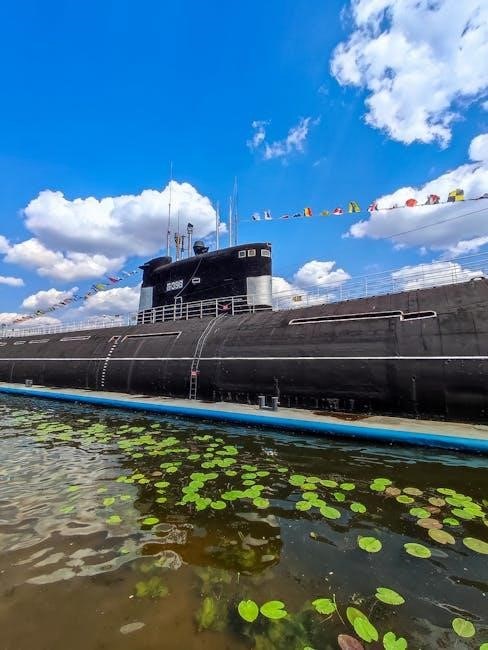
Modernization and Future Developments
Russia is modernizing its submarine fleet‚ focusing on advanced nuclear and diesel-electric designs to enhance strategic capabilities and maintain global maritime influence‚ despite challenges in construction.
5.1 Fleet Modernization and Replacement Programs
The Russian Navy is actively modernizing its submarine fleet to maintain strategic capabilities and counter global threats. Programs focus on replacing aging Soviet-era submarines with advanced designs like the Borei-class SSBNs and Yasen-class SSGNs. These initiatives aim to enhance nuclear deterrence‚ improve stealth technology‚ and integrate modern weaponry. The Borei-class‚ equipped with ballistic missiles‚ is central to Russia’s nuclear triad‚ while the Yasen-class multirole submarines bolster conventional capabilities. Shipbuilding centers like Sevmash are pivotal in these efforts‚ despite challenges such as budget constraints and technological advancements. The modernization underscores Russia’s commitment to sustaining a formidable underwater presence in global maritime security.
5.2 Next-Generation Submarine Projects (Borei‚ Yasen‚ and Lada)
Russia’s next-generation submarine projects‚ including the Borei‚ Yasen‚ and Lada classes‚ represent significant advancements in underwater capabilities. The Borei-class SSBNs are equipped with Bulava ballistic missiles‚ enhancing nuclear deterrence. Yasen-class SSGNs feature multirole capabilities‚ combining stealth with modern armament. The Lada-class submarines‚ with air-independent propulsion‚ improve endurance and quiet operations. These projects aim to modernize the fleet‚ ensuring technological parity with global competitors. Despite challenges‚ these submarines are critical for maintaining Russia’s naval presence and addressing future maritime security needs‚ showcasing the navy’s commitment to innovation and strategic readiness.
5.3 Role of Shipbuilding Industries in Submarine Production
Russia’s shipbuilding industries play a pivotal role in submarine production‚ driving technological advancements and ensuring fleet modernization. Key shipyards‚ such as Sevmash and Admiralty Shipyards‚ specialize in constructing nuclear and conventional submarines. These facilities are integral to manufacturing Borei‚ Yasen‚ and Lada-class submarines. The shipbuilding sector collaborates closely with defense ministries and research institutions to develop innovative designs and integrate cutting-edge technologies. Despite challenges like funding and sanctions‚ these industries remain vital for maintaining Russia’s submarine capabilities‚ ensuring national security‚ and supporting strategic naval operations globally.
5.4 Challenges and Opportunities in Submarine Construction
Russia’s submarine construction faces challenges such as funding constraints and international sanctions impacting technology imports. However‚ opportunities arise through domestic innovation and modernization efforts. Shipbuilding industries like Sevmash and Admiralty Shipyards continue to produce advanced submarines despite these hurdles. The development of new classes‚ such as Borei and Yasen‚ highlights Russia’s commitment to maintaining a competitive edge. These submarines feature cutting-edge nuclear propulsion and stealth capabilities‚ ensuring operational effectiveness. While challenges persist‚ Russia’s ability to adapt and innovate underscores its resilience in submarine construction‚ enabling the navy to remain a formidable force in global maritime security.
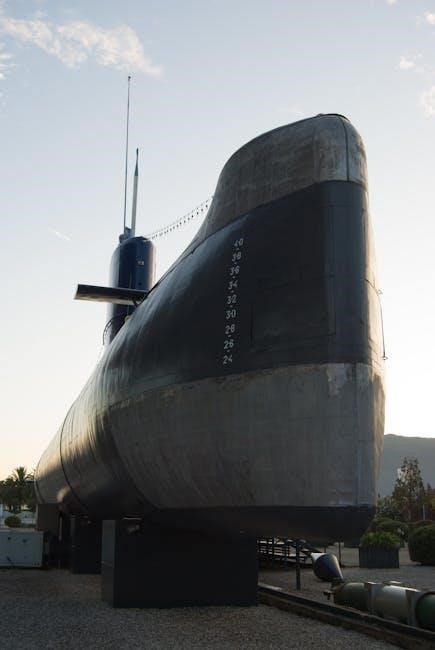
Global Impact and Assessments
Russian submarines play a pivotal role in global maritime security‚ influencing strategic deterrence and multirole operations. Their presence in Pacific‚ Arctic‚ and Atlantic regions underscores their operational capabilities and diplomatic weight‚ ensuring Russia’s competitive edge in naval power dynamics worldwide.
6.1 Comparison with Other Naval Forces (USA‚ China‚ NATO)
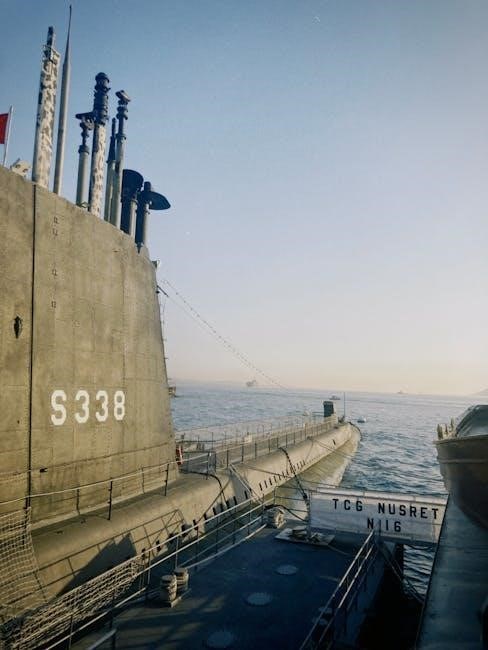
Russia’s submarine fleet is often compared to those of the USA‚ China‚ and NATO. The U.S. Navy emphasizes technological superiority with its Virginia-class submarines‚ while China focuses on quantity and regional dominance. NATO’s collective approach integrates member states’ fleets‚ enhancing interoperability. Russia‚ though with an aging fleet‚ maintains strategic relevance through nuclear deterrence and stealth technology advancements. The Borei and Yasen classes compete effectively in firepower. However‚ challenges like maintenance and production delays hinder Russia’s ability to match the scale of China’s rapid expansion or the technological edge of U.S. submarines. This dynamic shapes global underwater rivalry and strategic balances.
6.2 Espionage and Surveillance Concerns
Russian Navy submarines have raised significant espionage concerns due to their advanced stealth capabilities and suspected involvement in covert operations. The deployment of “doomsday submarines” equipped with nuclear torpedoes has sparked fears of radioactive tsunamis. These vessels‚ described as research platforms by Russia‚ are believed by others to serve espionage and surveillance purposes. Their ability to operate undetected near critical undersea infrastructure‚ such as communication cables‚ heightens concerns. Additionally‚ their presence in strategic regions like the Arctic and Atlantic underscores potential intelligence-gathering missions. These activities have led to increased vigilance from NATO and other naval powers‚ further intensifying global underwater surveillance tensions.
6.3 Economic and Political Implications of Submarine Deployments
Russian submarine deployments carry significant economic and political weight. The construction and maintenance of advanced submarines like the Borei and Yasen classes require substantial funding‚ impacting Russia’s defense budget. Politically‚ these deployments assert Russia’s global influence‚ particularly in contested regions such as the Arctic and Atlantic. The presence of Russian submarines near critical undersea infrastructure raises concerns about economic disruption‚ potentially threatening global trade and communications. Furthermore‚ these deployments reinforce Russia’s strategic deterrent capabilities‚ influencing geopolitical dynamics and military alliances. The economic burden and political leverage of these submarines underscore their dual role in projecting power and safeguarding national interests in an evolving global landscape.

6.4 Expert Assessments and Predictions for the Future
Experts predict that Russia’s submarine fleet will continue modernizing‚ focusing on stealth and advanced weaponry. Analysts highlight the Borei and Yasen classes as key to future operations‚ emphasizing their strategic deterrence and multirole capabilities. However‚ challenges such as economic constraints and Western sanctions may limit production rates. Some predict a shift towards smaller‚ more agile submarines‚ while others foresee increased reliance on unmanned underwater vehicles. The Russian Navy’s submarine program is expected to remain a critical component of its national security strategy‚ ensuring a balance between nuclear deterrence and conventional capabilities in an increasingly competitive global maritime environment over the next decade.
